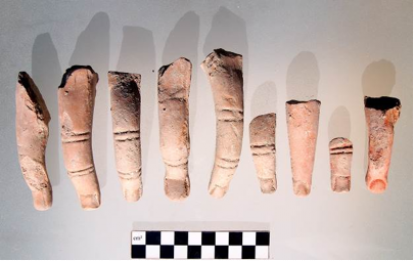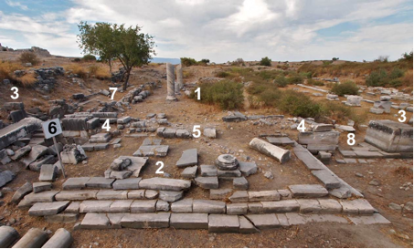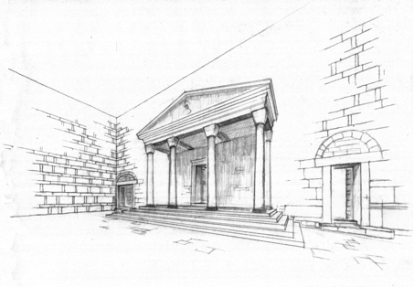Late Antiquity and Byzantine Miletus
Late Antiquity and Byzantine Miletus
Project Director: Philipp Niewöhner
Ancient Miletus was one of the foremost harbour cities on the west coast of Asia Minor, modern Turkey. Since 1899, on-going excavations have revealed much of the ancient city centre and many important monuments, in particular from the Archaic and the Roman Imperial periods.
A new research project on late antique and Byzantine Miletus was initiated in 2004 after the discovery of a large necropolis church. Annual field work campaigns have been on-going since 2006, and following the excavation of the necropolis basilica various other late antique and Byzantine monuments are now also under investigation. They include three more basilicas, one bath building, a house and a palace all from the early Byzantine period, three sets of fortifications from the 3rd, the 7th or 8th and from the late 11th or 12th centuries, middle Byzantine stone carvings, as well as a settlement and a chapel from the late Byzantine period. The project was initially conducted from Germany and then from the German Archaeological Institute at Istanbul before moving to Oxford late in 2011. Here it has since lead to international workshops and conferences on “Approaches to Middle Byzantine Miletus” in Trinity Term 2012 and on “Small Finds and the Big Gap in the Byzantine Settlement History of Miletus and Ephesus” in Trinity Term 2013.
2014 – 360° photography of the cave sanctuary
2013 – An ancient cave sanctuary and the Christianisation of the city in late antiquity
The excavation of an ancient cave sanctuary beneath the theatre castle has led to the discovery of human terra cotta limbs and mythological marble sculptures. The marbles were deposited in late antiquity, and the circumstances illuminate the process of Christianisation.
Dozens of fingers and other life-size limbs of burned clay may be identified as votive offerings for the cure of the respective limbs. They indicate that the cave was a healing shrine. It is centred on a karst spring that will have played a key part in the cure, but was filled in and blocked in the 4th/5th century AD. This probably happened after emperor Theodosius I had banned the ancient cults. The spring was filled in with half a dozen mythological marble sculptures that were deposited together with oil lamps and covered with roof tiles. The sculptures are missing noses and ears that had already been chopped off, probably by Christians, before the marbles were buried. Their deposition in the cave will have served to protect them from further damage. This seems to be confirmed by the oil lamps that were deposited together with the sculptures and suggest a proper burial ceremony. It may have been the last ritual act that sealed the healing spring and protected it, too, from profanation. Originally, the marbles will not have been displayed in the grotto. They differ in material, size, and stile, but all have fixtures that suggest an architectural context such as, for example, the stage building of the theatre.

Cave. The hole to the right of the central pillar contains the spring

Various life-size terra cotta fingers

Marble heads with broken noses
2012 - The Byzantine city walls and the medieval preservation of ancient monuments
When the Roman temple of Serapis (1) was excavated a century ago, it came as a surprise that nearly all parts of the colonnaded porch (2) had survived. They were found buried under the debris of the Byzantine city walls (3) that had collapsed in a medieval earthquake. The fortifications had incorporated the front wall of the Serapeum (4), and the porch with its lavish façade had remained standing outside the city walls right up until the earthquake. To the excavators writing in 1924 "it appeared incomprehensible why the temple porch was not demolished and the material re-used in the building of the fortifications."
During the 2012 fieldwork season, however, we were able to solve the puzzle. A re-examination of the city walls revealed that the temple porch had served as a monumental gate for the Byzantine city. The gateway consisted of three entrances, one being the old front door (5) of the Serapeum in the centre of the porch, the other two being new gates that flank the porch on either side. The west gate (6) opened onto an ancient street (7) leading to the church of St Michael and the so-called bishop's palace.

The excavated remains of the Roman temple of Serapis and the Byzantine city walls

Reconstructed elevation of the temple porch after its incorporation into a triple gateway of the city walls © Stefan Giese
The triple gateway that resulted formed the largest and most ornate entrance to the Byzantine city. The temple porch had been retained on account of its beauty and venerable antiquity – in other words a conservationist approach to ancient buildings. What had "appeared incomprehensible" to the early excavators has since been observed more often at Miletus, where the Late Antique and Byzantine inhabitants took an evident pride in the preservation and display of their ancient heritage.
Publications
- P. Niewöhner, Neue spät- und nachantike Monumente von Milet und der mittelbyzantinische Zerfall des anatolischen Städtwesens, Archäologischer Anzeiger, in press (with contributions from O. Dally – E. Erkul – S. Feist – S. Giese – D. Göcmen – T. Hintermann – M. Kruip – M. Maischberger – B. Raubo – P. Schneider – A. Scholl – N. Schwert – V. Sossau – F. Stroth – H. Stümpel)
- P. Niewöhner, The Riddle of the Market Gate. Miletus and the Character and Date of the Earlier Byzantine Fortifications of Anatolia, in: O. Dally – C. Ratté (ed.), Archaeology and the Cities of Asia Minor in Late Antiquity, Kelsey Museum Publication 6 (Ann Arbor, Mi. 2011) 103-122
- P. Niewöhner, Milet in frühbyzantinischer Zeit, in: O. Dally et al. (ed.), ZeitRäume. Milet in Kaiserzeit und Spätantike (Regensburg 2009) 60-67
- P. Niewöhner, Sind die Mauern die Stadt? Vorbericht über die siedlungsgeschichtlichen Ergebnisse neuer Grabungen im spätantiken und byzantinischen Milet. Mit geoarchäologischen Anmerkungen zur Friedhofskirche von H. Brückner und M. Müllenhoff, Archäologischer Anzeiger 2008/1, 181-201
- Die große Friedhofskirche von Milet. Vorbericht über die Ausgrabung einer neu entdeckten Transeptbasilika, Mitteilungen zur Christlichen Archäologie 13, 2007, 71-90
- P. Niewöhner, Byzantinische Steinmetzarbeiten aus dem Umland von Milet, Anadolu ve Çevresinde Ortaçağ 1, 2007, 1-28
The excavations at Miletus are principally funded by the German Archaeological Institute. The growing involvement of students and scholars from Oxford has been supported by the Craven Committee, the Oxford Centre for Byzantine Research, the Meyerstein Bequest, and various collegiate travel and reasearch grants.
Contact: Philipp.Niewoehner@arch.ox.ac.uk



